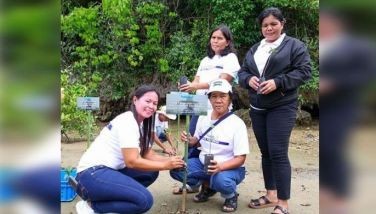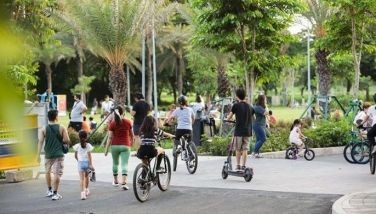Bangus, puto, oysters & Joseph Estrada
March 26, 2006 | 12:00am
We went fishing in Dagupan, Pangasinan, and with Joseph Estrada, no less. No, not the one facing plunder charges, but a man who raises oysters and helps in harvesting at least five tons of bangus a day from the placid waters of the Dawel River.
The invitation to witness the guilon-guilon (harvest) of the very famous Bonuan bangus came from our friend Rosary on behalf of Marigold Commodities Corp., makers of Mama Sita’s mixes, seasoning and sauces. Needless to say, we looked forward to a delightful weekend savoring our favorite fish in good company.
That Saturday started at a hambuger chain in Cubao where the early birds (actually, those who were punctual) had breakfast. Dagupan is quite a distance from Metro Manila, but we had a stop in Tarlac and with smooth roads, we reached our destination around noon, in time for a picnic lunch at the Fish Pond in Salapingao.
For a couple with weak knees in the group, getting into a motorized boat and negotiating the bamboo bridge was rather challenging, but fear and tiredness disappeared as soon as we saw the luscious and generous spread on the table. In the course of lunch we found out what makes Bangus Bonuan really special. The fingerlings eat the algae under the water and are left to grow to not more than a kilo in weight each. It takes four months before harvest time and when ready, they are fed with bread, a cleansing agent, which makes the fish wholly edible–that is, the entrails may be eaten as well.
This process also gives it the milky taste, from belly to tail, hence its name milkfish. The distinctive features of this fish–which we never knew until this trip–are a small head, short tail and protruding belly. If there’s not much taba ng tiyan in the fish, it is because the fat is distributed throughout its body, making it tasty all throughout.
No one bothered with being dainty as everyone excitedly peeled prawns, cracked crabs and slurped fresh buko juice. Bangus, of course, was the stellar attraction, grilled to perfection and made into sinigang. Mama Sita’s liquid seasoning ("ulam na," said our kitchen assistant when we got home and gave her the bottle) was an ideal companion to the inihaw, just as the Sinigang sa Bayabas mix was a super flavoring.
Dessert consisted of mangoes for which the province is famous, bananas and turnips on sticks. Later, Mama Sita’s Heidi gave us a demonstration of how the sinigang was done. Easy.
After checking in and freshening up at the sprawling Leisure Coast Resort Hotel, the group was off to bagoong country and puto town. Strange that the bulk of the small fish (anchovies, tulingan) LC (the manufacturer) uses for her fish bagoong comes not from Pangasinan but from neighboring provinces and as far away as Bicol and Iloilo. She has a big operation but we thought she could use some technical advise and modern facilities, perhaps with government assistance.
Calasiao is puto town, where those little shiny sticky white and brown rice cakes one buys in the big city come from. Ester Agsalud Barcelon is based in Barangay Dinaloan and has been in the business for years and years. There’s nothing complicated about her puto; it’s simply a mixture of rice flour, sugar and water. Now the secret is the banga, a clay pot where the mixture is left to rise overnight. No, nothing can substitute for this piece of equipment. Along the East Poblacion, her rice cakes are sold in a long row of stalls, under the Multi-Purpose Cooperative, which also carries suman, mangoes (P40 a kilo) and more. Here the puto sells for P45 a kilo of about 90 pieces.
The evening saw us going back, after quite some time, to the popular Dagupeña restaurant in its new headquarters, also in Calasiao. While we had our fill of the puto and cuchinta, driving through the night and nearly getting lost whetted our appetite.
Dagupeña, neat and bright, was full but the staff was quick and efficient. Needless to say there was bangus on the menu, but we really did not mind; it’s a fish we can enjoy forever. We were served Fisherman’s Soup of crabs, shrimps and clams cooked in ginger. Sizzling bangus with liquid seasoning and the house specialty, Binagoongang Pata, was sinful but super. The house chef gave a demo where he used Mama Sita’s Oyster Sauce for the bangus belly with onion rings. Nothing complicated. It was like doing the traditional bistek, but using fish instead of beef and oyster sauce in lieu of soy sauce. Great!
On Sunday, we had an early morning call. We were going, finally to the guilon-guilon. We cruised down the river, noting the mangroves and the lovely sight of fish pens enclosed in nets and bamboo poles with nipa huts after so many meters.
Here we met Joseph Estrada, who told us that unless there was a buyer no harvest could be done. We can see why, because each haul is about five tons costing a whopping half a million pesos! The catch, which they sell for as low as P70 a kilo, initially ends up in the Magsaysay market where they are distributed, making their way to the big cities such as Manila where they end up tagged from P100 to P140 a kilo. We had quite a wait on the boat, under the blazing sun, because everything had to be set up–boat, equipment, men (who get P300 each per harvest).
When it finally happened, we were all in awe–seeing the jumping bangus (first time we saw them like this) like a burst of fireworks, the men working the bamboo poles, diving to the bottom of the river, pulling the nets up and finally transferring the catch to the waiting boats.
On the other side of the river, Joseph raises his oysters and harvest is done by pulling the cages up. Most of them end up in Mama Sita’s new Oyster Sauce.
The last lunch was at Silverio’s where the fish called magala (belonging to the family of samaral) was served as sinigang. We also had sweet mangoes. Soon it was time to end an idyllic weekend, but not without stopping on the way to pick up native garlic (P110 a kilo against P200-plus in the city) and sibuyas tagalog (P50 a kilo).
We had a very delicious stop along MacArthur Highway in Barrio Estrada (again!) in Capas, Tarlac at the Coconut Grill Resort and Restaurant, a lovely garden place where we met the gracious general manager Milit Baron and her equally smiling staff. They served a buffet of pancit palabok with camias, pancit buko, lumpia, crispy coated kamote and more, plus halo-halo which nobody could resist. A fitting final meal before heading home.
Foodies and homemakers must thank Mama Sita (Teresita Reyes) for her foresight and desire to keep the tradition of delicious Filipino cooking, in the course concocting enhancers that make good cooks out of ordiinary housekeepers. Her efforts are paying off in the dedication of her children, even apos, and the progressive and innovative team that enables the Marigold Commodities Corporation to attain its goals.
They now have a long list of seasonings, sauces and mixes, from tocino to caldereta, from barbecue marinades to adobo, even lechon sauce, making life much easier for women. We were told that these seasonings and sauces are available in some foreign countries, which should be great news for Pinoys living abroad.
For this most informative, delicious and enjoyable trip, we thank Rosary, Ramon, Heidi, Cora and Eric. Plus our efficient driver Mang Gil.
And yes, Joseph Estrada, the bangus and oyster man.
The invitation to witness the guilon-guilon (harvest) of the very famous Bonuan bangus came from our friend Rosary on behalf of Marigold Commodities Corp., makers of Mama Sita’s mixes, seasoning and sauces. Needless to say, we looked forward to a delightful weekend savoring our favorite fish in good company.
That Saturday started at a hambuger chain in Cubao where the early birds (actually, those who were punctual) had breakfast. Dagupan is quite a distance from Metro Manila, but we had a stop in Tarlac and with smooth roads, we reached our destination around noon, in time for a picnic lunch at the Fish Pond in Salapingao.
For a couple with weak knees in the group, getting into a motorized boat and negotiating the bamboo bridge was rather challenging, but fear and tiredness disappeared as soon as we saw the luscious and generous spread on the table. In the course of lunch we found out what makes Bangus Bonuan really special. The fingerlings eat the algae under the water and are left to grow to not more than a kilo in weight each. It takes four months before harvest time and when ready, they are fed with bread, a cleansing agent, which makes the fish wholly edible–that is, the entrails may be eaten as well.
This process also gives it the milky taste, from belly to tail, hence its name milkfish. The distinctive features of this fish–which we never knew until this trip–are a small head, short tail and protruding belly. If there’s not much taba ng tiyan in the fish, it is because the fat is distributed throughout its body, making it tasty all throughout.
No one bothered with being dainty as everyone excitedly peeled prawns, cracked crabs and slurped fresh buko juice. Bangus, of course, was the stellar attraction, grilled to perfection and made into sinigang. Mama Sita’s liquid seasoning ("ulam na," said our kitchen assistant when we got home and gave her the bottle) was an ideal companion to the inihaw, just as the Sinigang sa Bayabas mix was a super flavoring.
Dessert consisted of mangoes for which the province is famous, bananas and turnips on sticks. Later, Mama Sita’s Heidi gave us a demonstration of how the sinigang was done. Easy.
After checking in and freshening up at the sprawling Leisure Coast Resort Hotel, the group was off to bagoong country and puto town. Strange that the bulk of the small fish (anchovies, tulingan) LC (the manufacturer) uses for her fish bagoong comes not from Pangasinan but from neighboring provinces and as far away as Bicol and Iloilo. She has a big operation but we thought she could use some technical advise and modern facilities, perhaps with government assistance.
Calasiao is puto town, where those little shiny sticky white and brown rice cakes one buys in the big city come from. Ester Agsalud Barcelon is based in Barangay Dinaloan and has been in the business for years and years. There’s nothing complicated about her puto; it’s simply a mixture of rice flour, sugar and water. Now the secret is the banga, a clay pot where the mixture is left to rise overnight. No, nothing can substitute for this piece of equipment. Along the East Poblacion, her rice cakes are sold in a long row of stalls, under the Multi-Purpose Cooperative, which also carries suman, mangoes (P40 a kilo) and more. Here the puto sells for P45 a kilo of about 90 pieces.
The evening saw us going back, after quite some time, to the popular Dagupeña restaurant in its new headquarters, also in Calasiao. While we had our fill of the puto and cuchinta, driving through the night and nearly getting lost whetted our appetite.
Dagupeña, neat and bright, was full but the staff was quick and efficient. Needless to say there was bangus on the menu, but we really did not mind; it’s a fish we can enjoy forever. We were served Fisherman’s Soup of crabs, shrimps and clams cooked in ginger. Sizzling bangus with liquid seasoning and the house specialty, Binagoongang Pata, was sinful but super. The house chef gave a demo where he used Mama Sita’s Oyster Sauce for the bangus belly with onion rings. Nothing complicated. It was like doing the traditional bistek, but using fish instead of beef and oyster sauce in lieu of soy sauce. Great!
On Sunday, we had an early morning call. We were going, finally to the guilon-guilon. We cruised down the river, noting the mangroves and the lovely sight of fish pens enclosed in nets and bamboo poles with nipa huts after so many meters.
Here we met Joseph Estrada, who told us that unless there was a buyer no harvest could be done. We can see why, because each haul is about five tons costing a whopping half a million pesos! The catch, which they sell for as low as P70 a kilo, initially ends up in the Magsaysay market where they are distributed, making their way to the big cities such as Manila where they end up tagged from P100 to P140 a kilo. We had quite a wait on the boat, under the blazing sun, because everything had to be set up–boat, equipment, men (who get P300 each per harvest).
When it finally happened, we were all in awe–seeing the jumping bangus (first time we saw them like this) like a burst of fireworks, the men working the bamboo poles, diving to the bottom of the river, pulling the nets up and finally transferring the catch to the waiting boats.
On the other side of the river, Joseph raises his oysters and harvest is done by pulling the cages up. Most of them end up in Mama Sita’s new Oyster Sauce.
The last lunch was at Silverio’s where the fish called magala (belonging to the family of samaral) was served as sinigang. We also had sweet mangoes. Soon it was time to end an idyllic weekend, but not without stopping on the way to pick up native garlic (P110 a kilo against P200-plus in the city) and sibuyas tagalog (P50 a kilo).
We had a very delicious stop along MacArthur Highway in Barrio Estrada (again!) in Capas, Tarlac at the Coconut Grill Resort and Restaurant, a lovely garden place where we met the gracious general manager Milit Baron and her equally smiling staff. They served a buffet of pancit palabok with camias, pancit buko, lumpia, crispy coated kamote and more, plus halo-halo which nobody could resist. A fitting final meal before heading home.
Foodies and homemakers must thank Mama Sita (Teresita Reyes) for her foresight and desire to keep the tradition of delicious Filipino cooking, in the course concocting enhancers that make good cooks out of ordiinary housekeepers. Her efforts are paying off in the dedication of her children, even apos, and the progressive and innovative team that enables the Marigold Commodities Corporation to attain its goals.
They now have a long list of seasonings, sauces and mixes, from tocino to caldereta, from barbecue marinades to adobo, even lechon sauce, making life much easier for women. We were told that these seasonings and sauces are available in some foreign countries, which should be great news for Pinoys living abroad.
For this most informative, delicious and enjoyable trip, we thank Rosary, Ramon, Heidi, Cora and Eric. Plus our efficient driver Mang Gil.
And yes, Joseph Estrada, the bangus and oyster man.
BrandSpace Articles
<
>
- Latest
- Trending
Trending
Latest













